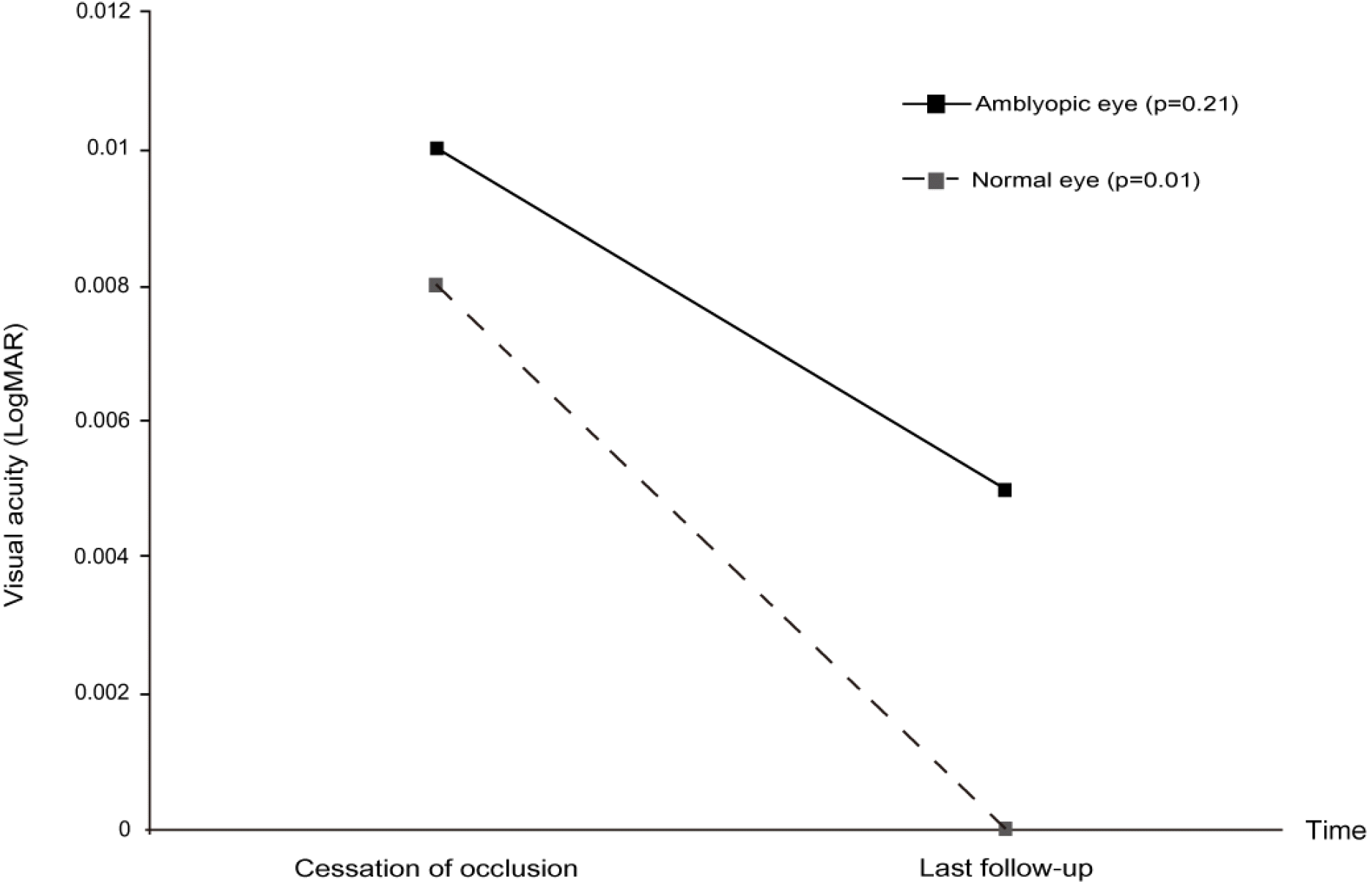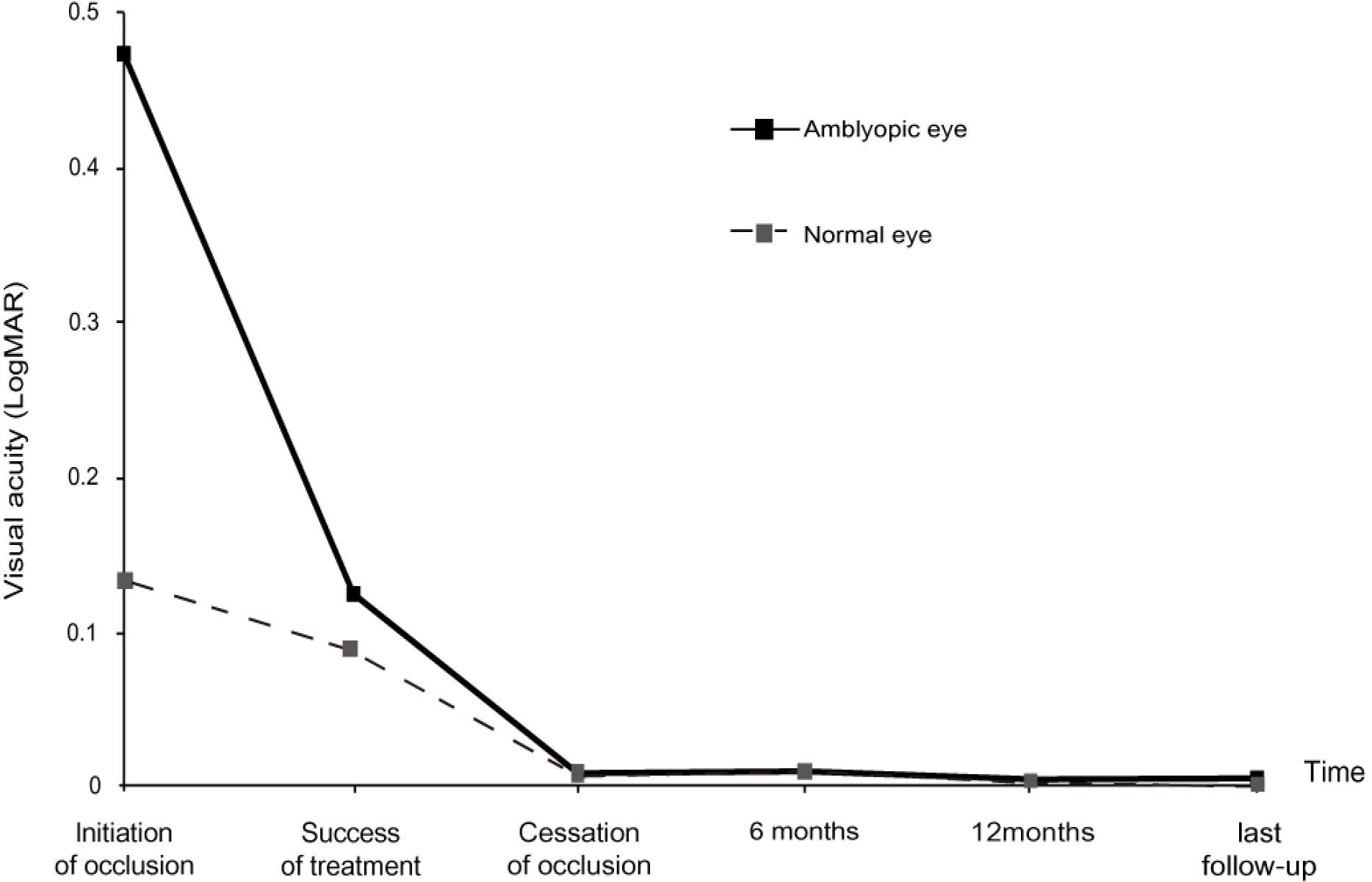Abstract
Purpose
To evaluate a long-term visual outcome following cessation of occlusion therapy in unilateral amblyopia.
Methods
A total of 70 patients who successfully finished occlusion therapy (including maintenance therapy) for unilateral amblyopia and were followed up for at least 1 year after cessation of occlusion were retrospectively reviewed. Even after the success of occlusion therapy, maintenance therapy or regular examinations were performed until the visual development of the normal fellow eye (NE) was completed. The recurrence of amblyopia was defined as a 2 or more logarithm of the minimum angle of resolution (LogMAR) levels of visual acuity (VA) reduction of the amblyopic eye (AE), as compared to the NE, at the last evaluation.
Results
Amblyopia was associated with strabismus in 19 patients, anisometropia in 33 patients, and both in 39 patients. The mean age at the cessation of occlusion and at the last evaluation was 7.7 ± 1.9 years and 11.4 ± 2.9 years, respectively. The mean VA of the AE was 0.01 ± 0.03 and mean stereopsis was 101.7 ± 87.5 seconds of arc at the cessation of occlusion, and both improved at the last evaluation. However, the improvement of mean VA of the AE was not statistically significant (p = 0.21). The mean duration of maintenance therapy was 25.6 ± 21.0 months, and was 3 times longer than the duration required to achieve success in the treatment of amblyopia. At the last evaluation, the recurrence of amblyopia was not found, while 3 patients (4.3%) lost 1 LogMAR level of VA in the AE, as compared to the NE.
Go to : 
References
1. Tacagni DJ, Stewart CE, Moseley MJ, Fielder AR. Factors affecting the stability of visual function following cessation of occlusion therapy for amblyopia. Graefes Arch Clin Exp Ophthalmol. 2007; 245:811–6.

2. Holmes JM, Beck RW, Kraker RT, et al. Riks of amblyopia recurrence after cessation of treatment. J AAPOS. 2004; 8:420–8.
3. Bhola R, Keech RV, Kutschke P, et al. Reccurence of amblyopia after occlusion therapy. Ophthalmology. 2006; 113:2097–100.
4. Ohlsson J, Baumann M, Sjostrand J, Abrahamsson M. Long term visual outcome in amblyopia treatment. Br J Ophthalmol. 2002; 86:1148–51.

5. Oster JG, Simon JW, Jenkins P. When is it safe to stop patching? Br J Ophthalmol. 1990; 74:709–11.

6. Scott WE, Dickey CF. Stability of visual acuity in amblyopic patients after visual maturity. Graefes Arch Clin Exp Ophthalmol. 1988; 226:154–7.

7. Holmes JM, Melia M, Bradfield YS, et al. Factors aassociated with recurrence of amblyopia on cessation of patching. Ophthalmology. 2007; 114:1427–32.
8. Ching FC, Parks MM, Friendly DS. Practical management of amblyopia. J Pediatr Ophthalmol Strabismus. 1986; 23:12–6.

9. Malik SR, Virdi PS, Goel BK. Follow-up results of occlusion and pleoptic treatment. Acta Ophthalmol (Copenh). 1975; 53:620–6.

10. Levartovsky S, Oliver M, Gottesman N, Shimshoni M. Factors affecting long term results of successfully treated amblyopia: innitial visual acuity and type of amblyopia. Br J Ophthalmol. 1995; 79:225–8.
11. Woo KJ, Choi MY. The clinical features with recurrence of amblyopia after cessation of amblyopia treatment. J Korean Ophthalmol Soc. 2009; 50:1705–11.
12. Von Noorden GK. Binocular Vision and Ocular Motility. 6th ed.St. Louis: C.V. Mosby;2002. p. 548.
Go to : 
 | Figure 2.The improvement of mean visual acuity from cessation of occlusion to the last follow-up. |
Table 1.
Comparison of visual acuity between the amblyopic eye and the normal eye
Table 2.
Clinical characteristics of three patients with one-line interocular difference in visual acuity at the last follow-up
| Patient | Cause of amblyopia | Age at IO*(yrs) | Initial VA†(LogMAR) | Duration of maintenance (mon) | Age at CO‡(yrs) | VA* at CO‡(LogMAR) | Stereopsis at CO‡(Seconds of arc) | Age at the last follow-up (yrs) |
|---|---|---|---|---|---|---|---|---|
| Total | | 4.8 ± 1.8 | 0.47 | 25.6 ± 21 | 7.7 ± 1.9 | 0.01 | 101.7 ± 87.5 | 11.4 ± 2.9 |
| A | Mixed | 5.6 | 0.3 | 12 | 7.3 | 0.00 | 40 | 12.9 |
| B | Anisometropic | 3.7 | 1.0 | 37 | 7.5 | 0.00 | 100 | 12.3 |
| C | Strabismic | 2.0 | 1.7 | 91 | 10.2 | 0.05 | 200 | 12.2 |




 PDF
PDF ePub
ePub Citation
Citation Print
Print



 XML Download
XML Download